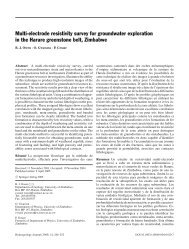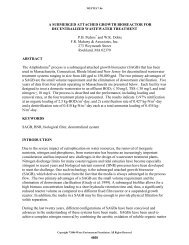The design and operation of conventional and novel flotation ...
The design and operation of conventional and novel flotation ...
The design and operation of conventional and novel flotation ...
You also want an ePaper? Increase the reach of your titles
YUMPU automatically turns print PDFs into web optimized ePapers that Google loves.
J. Officer et al. 64<br />
Figure 1 Schematic diagram <strong>of</strong> the <strong>conventional</strong> DAF Process<br />
Figure 2 Typical arrangement <strong>of</strong> a COCODAFF ® unit<br />
This paper describes five <strong>flotation</strong> plants, two <strong>of</strong> which are <strong>conventional</strong> DAF plants, while<br />
the remaining three are COCODAFF ® . Recent work on flow distribution <strong>and</strong> FEA is also<br />
described.<br />
Conventional <strong>flotation</strong><br />
<strong>The</strong> <strong>conventional</strong> DAF plants described in this paper are Farmoor WTW (109 Ml/d) in<br />
Southern Engl<strong>and</strong>, operated by Thames Water, <strong>and</strong> Carron Valley WTW (125 Ml/d) in<br />
Scotl<strong>and</strong>, operated by East <strong>of</strong> Scotl<strong>and</strong> Water. Farmoor WTW treats reservoir stored water<br />
derived from the River Thames, which is a typical lowl<strong>and</strong> source <strong>of</strong> high alkalinity <strong>and</strong><br />
subject to seasonal blooms <strong>of</strong> algae. Carron Valley WTW treats reservoir stored water<br />
derived from the Rivers Carron <strong>and</strong> Endrick, which is a moderately coloured upl<strong>and</strong> water<br />
<strong>of</strong> low alkalinity <strong>and</strong> hardness <strong>and</strong> which is subject to moderate blooms <strong>of</strong> algae.
















